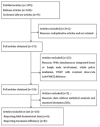Dosimetric comparison of intensity-modulated radiotherapy and volumetric-modulated arc radiotherapy in patients with prostate cancer: a meta-analysis
- PMID: 27929498
- PMCID: PMC5690508
- DOI: 10.1120/jacmp.v17i6.6464
Dosimetric comparison of intensity-modulated radiotherapy and volumetric-modulated arc radiotherapy in patients with prostate cancer: a meta-analysis
Abstract
Intensity-modulated radiotherapy (IMRT) and volumetric-modulated arc therapy (VMAT) are two main radiotherapy techniques. The aim of this study is to explore which is the preferred technique in prostate treatment through the related publica-tions and meta-analysis. Two authors independently identified all relevant articles available regarding eligibility criteria on PubMed, Embase, and Cochrane Library databases until December 2015. Publication bias was evaluated with funnel plot, and statistical analyses were performed with Stata software. P < 0.05 was thought statistically significant. Ten studies comprised a total of 110 patients; in total 110 IMRT plans and 110 VMAT plans that were included in this study. V40, V60, and V70 of rectum were significantly decreased in VMAT than in IMRT. However, V50 of rectum and V40, V50, V60, V70 of bladder had no statistical differences between IMRI and VMAT plans. Compared with IMRT, the treatment time and MUs of VMAT were significantly lower. VMAT protects rectum better than IMRT and improves the delivery efficiency. VMAT may be the preferred modality for treating prostate cancer.
© 2016 The Authors.
Figures







Similar articles
-
Treatment planning comparison of IMPT, VMAT and 4π radiotherapy for prostate cases.Radiat Oncol. 2017 Jan 11;12(1):10. doi: 10.1186/s13014-016-0761-0. Radiat Oncol. 2017. PMID: 28077128 Free PMC article.
-
A dosimetric comparison of tomotherapy and volumetric modulated arc therapy in the treatment of high-risk prostate cancer with pelvic nodal radiation therapy.Int J Radiat Oncol Biol Phys. 2013 Feb 1;85(2):549-54. doi: 10.1016/j.ijrobp.2012.03.046. Epub 2012 Jun 5. Int J Radiat Oncol Biol Phys. 2013. PMID: 22677369
-
Dosimetric benefits of intensity-modulated radiotherapy and volumetric-modulated arc therapy in the treatment of postoperative cervical cancer patients.J Appl Clin Med Phys. 2017 Jan;18(1):25-31. doi: 10.1002/acm2.12003. Epub 2016 Nov 21. J Appl Clin Med Phys. 2017. PMID: 28291936 Free PMC article.
-
Adaptive optimization by 6 DOF robotic couch in prostate volumetric IMRT treatment: rototranslational shift and dosimetric consequences.J Appl Clin Med Phys. 2015 Sep 8;16(5):35-45. doi: 10.1120/jacmp.v16i5.5525. J Appl Clin Med Phys. 2015. PMID: 26699314 Free PMC article. Review.
-
Volumetric modulated arc therapy: a review of current literature and clinical use in practice.Br J Radiol. 2011 Nov;84(1007):967-96. doi: 10.1259/bjr/22373346. Br J Radiol. 2011. PMID: 22011829 Free PMC article. Review.
Cited by
-
Plan quality for high-risk prostate cancer treated with high field magnetic resonance imaging guided radiotherapy.Phys Imaging Radiat Oncol. 2018 Jul 21;7:1-8. doi: 10.1016/j.phro.2018.06.006. eCollection 2018 Jul. Phys Imaging Radiat Oncol. 2018. PMID: 33458398 Free PMC article.
-
Volumetric modulated arc therapy (VMAT): a review of clinical outcomes-what is the clinical evidence for the most effective implementation?Br J Radiol. 2022 Aug 1;95(1136):20201289. doi: 10.1259/bjr.20201289. Epub 2022 Jul 4. Br J Radiol. 2022. PMID: 35616646 Free PMC article. Review.
-
Stereotactic Body Radiation Therapy (SBRT) in prostate cancer in the presence of hip prosthesis - is it a contraindication? A narrative review.BMC Urol. 2024 Jul 26;24(1):152. doi: 10.1186/s12894-024-01479-8. BMC Urol. 2024. PMID: 39061006 Free PMC article. Review.
-
Fecal incontinence after moderately hypofractionated volumetric modulated arc therapy for prostate cancer: incidence and impact on quality of life.Clin Transl Oncol. 2025 Apr 22. doi: 10.1007/s12094-025-03926-w. Online ahead of print. Clin Transl Oncol. 2025. PMID: 40261490
-
Dosimetric comparison of volumetric-modulated arc therapy and intensity-modulated radiation therapy in patients with cervical cancer: a meta-analysis.Onco Targets Ther. 2018 Oct 18;11:7179-7186. doi: 10.2147/OTT.S178336. eCollection 2018. Onco Targets Ther. 2018. PMID: 30425510 Free PMC article.
References
-
- Gomez‐Millan J, Lara MF, Correa Generoso R, Perez‐Rozos A, Lupiañez‐Perez Y, Medina Carmona JA. Advances in the treatment of prostate cancer with radiotherapy. Crit Rev Oncol Hematol. 2015;95(2):144–53. - PubMed
-
- Khor R and Williams S. Contemporary issues in radiotherapy for clinically localized prostate cancer. Hematol Oncol Clin North Am. 2013;27(6):1137–62. - PubMed
-
- Wilkins A and Parker C. Treating prostate cancer with radiotherapy. Nat Rev Clin Oncol. 2010;7(10):583–89. - PubMed
-
- Aluwini S, Pos F, Schimmel E, et al. Hypofractionated versus conventionally fractionated radiotherapy for patients with prostate cancer (HYPRO): acute toxicity results from a randomised non‐inferiority phase 3 trial. Lancet Oncol. 2015;16(3):274–83. - PubMed
-
- Ezzell GA, Galvin JM, Low D, et al. Guidance document on delivery, treatment planning, and clinical implementation of IMRT: Report of the IMRT Subcommittee of the AAPM Radiation Therapy Committee. Med Phys. 2003;30(8):2089–115. - PubMed
Publication types
MeSH terms
LinkOut - more resources
Full Text Sources
Other Literature Sources
Medical

